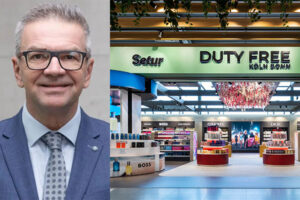I see the need for a change in the retail and shopping center industries. There is no clear action on this today and on how to tackle retail security’s “new normal.”
- Who takes responsibility for ensuring a safe and secure shopping environment?
- What do retailers need to think about to ensure the safety and security of a shopping center for their staff and customers, as well as for their brand, business, and profits?

CEO of Safe ShoppingCenters
Image: Safe ShoppingCenters
The situation is not actually new, but now it’s right in our backyard, in retail, in shopping centers, and in the news, so we need to adapt our business and take responsibility.
This is of course a problem in general for society and for our authorities, but we, the shopping center owners and operators and the retailers, are the ones who know the industry best. I come from the retail industry, from the Swedish international retailers Lindex and IKEA. I have worked internationally for more than 20 years with risk and security management and a decade with retail safety and security. I see a “game changer” as far as what international retailers should expect and demand from shopping center operators and landlords when signing a lease contract to ensure the safety of their staff, customers, and brand.
This is an ever-growing concern and a dilemma for retailers in shopping centers. Shopping centers must ensure the safety of their tenants and visitors. Shopping centers must be able to demonstrate a duty of care towards their tenants and visitors. It is NOT about insurance—we’re talking about a management framework, a structure, and a systematic way of working with safety and security, including business continuity and building resilience.
There are clear expectations from society and retailers today—a shopping center must be a safe and secure place for shopping, bringing your family, and spending your time and money. Today there is demand for a common standard for shopping centers to be able to benchmark the level of risk and security. Retailers should expect from shopping centers and landlords that they will carry out their duty of care and protect their staff, visitors, and profits.
Leasing contracts
Shopping center operators and landlords must consider safety, security, and anti-terror strategies as part of their “normal” operations and this requires a new set of terms in leasing contracts and conditions.
There also need to be changes to lease contracts today that stipulate that retailers and subcontractors must ensure that the right staff members are actually the ones working on site and this must also be checked and not just added to the contract for liability reasons. Know Your Customer.
This means background checks on tenants, co-workers, and subcontractors to ensure the identity of the people entering your premises and working in your business environment.
Awareness and training: Retailers must also ensure that staff members are properly trained in the safe and secure evacuation of customers from the store and that they actively participate in active shooter and anti-terrorist awareness training and safety and security training in the shopping center.
This must go beyond living up to local minimum requirements, as these are too lax. This is a challenge: Retailers are well aware of their costs and how they spend their time in the store to improve profits and stores’ commercial attractiveness. This commitment must come from retail as well.
Shopping center operators and landlords must also be quick to adapt to the increasing focus on “soft” targets, and commercial landlords, along with retailers and all of us, will have a role to play. Places most at risk will continue to be ones that have unrestricted access, heavy footfall, and large amounts of public space where it is difficult to establish a secure perimeter—a pretty good description of a typical shopping center.
What can be done?
There must be a change in attitude from all parties to be able to tackle the new “shopping normal” for the retail and shopping center industry and maintain customers’ trust. Shopping center managers are professionals and know their business—as long as everything is going according to plan.
This is not always the case… Fundamentally, the best protective strategies come down to prevention through awareness and continued vigilance, competence through training and information, and to including retailers in the work on the shopping center.
Today, my understanding is that most shopping center operators are actually “afraid” to put demands for safety and security to their tenants with training and systematic follow-up.
The reason is simple: They do not want to “disturb” their business and of course retailers also keep a tight grip on spending staff hours in the store, as this is a cost. It’s not enough to “just” put the liability clauses in the contract and leave it at that. There is also a duty of care to consider.
Heightened vigilance, improved surveillance, systematic interaction with the police and other rescue services, and training (such as live simulation exercises), are all increasingly important and may have to become as common as fire drills, which are a natural part of the business today. But if retailers are not willing to help the shopping center industry, it will be impossible.

Security Risk management
It is vital to develop a structured, systematic and well-integrated way of working to identify threats to the shopping center business and its environment. Most new property developments now incorporate physical defenses into their design.
In addition to traditional barriers and bollards, possibilities include bomb-proof litter bins and “hardened” external landscaping, such as seating and planters doubling up as barriers to prevent vehicles being driven close to or into properties. These can also be easily retrofitted to increase the perimeter security of existing buildings.
Planning guidance and dedicated advice on designing for anti-terrorism without turning the retail experience and the shopping center into Fort Knox are available.
In a free and open society, no security infrastructure can ever remove all risks—a shopping center operator will need to accept the risk and find the right actions and mitigations and implement these into the “new” normal operations of business for retail.
Traditional evacuation procedures will need to be continually reviewed and adapted to the new reality of terrorism and to other upcoming threats and events like natural disasters.
After all, physical defenses would not have prevented the lower-level “lone wolf” types of attacks witnessed lately in Munich, France and elsewhere around the world. These will most likely recur and we must be prepared.
We can prepare and ensure resilience and security for our shopping centers, retailers, and customers. We can definitely improve and ensure that we offer a great customer experience and that everyone feels safe while retail shopping in our shopping centers in a balanced way while avoiding the “security dilemma” by adapting to the “new” retail business normal to make security an integrated part of our business strategies.

What is your opinion on this topic? Discuss it with us! Send your opinion to opinion@across-magazine.com !






